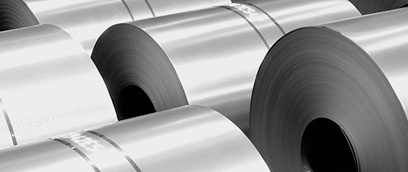With steel one of the top metals used in metal stamping, global market fluctuations in the supply and demand for steel have been pushing steel prices lower and shortening lead times for delivery for much of the past year. That price decrease is good news for manufacturers who use steel in components such as metal stampings.
It may take some time for OEMs to benefit from price drops, as metal stamping firms buy steel on one-year contracts for production runs with blanket purchase orders. For new projects, steel can be purchased on the spot market. However, prices are volatile and have shown signs of edging up.
Types of steel used in metal stampings
Steel is one of the toughest metals available, so it is the best choice for many industrial applications for metal stampings.
The most frequently used types of steel in metal stamping are:
- Hot rolled steel, which is suited for larger, structural components such as I-bars, and is used to produce sheet metal
- Cold rolled steel, which is harder but can be formed into parts with tighter tolerances
- Hot-dipped galvanized steel, which is coated with zinc to prevent rust
Fluctuating lead times for steel
The lead times for steel, whether imported or domestic, are driven by market demand, which is also affected by foreign currency values that impact prices. According to Jim Shotsberger, purchasing manager for Kenmode, “As the dollar has strengthened in value, steel manufacturers overseas have increased supply and decreased prices, forcing U.S. steel manufacturers to decrease prices as well. When supply exceeds demand, lead times drop significantly.”
When global demand is high, lead times for steel deliveries can run from 10 to 12 weeks. With lower demand, lead times can be as short as six weeks or even four weeks for U.S. steel mills. Hot-dipped galvanized steel generally requires an extra week over other types of steel. For stock purchases from a steel service center, it may be possible to get steel in just one week. For new production runs, OEMs should factor in a steel delivery time of 8 to 10 weeks.
The metal stamping firm may purchase the steel directly, rather than having their OEM client purchase it. Shotsberger observes that U.S. customers for metal stampings that incorporate steel aim to balance the best quality with the lowest price when evaluating the price of steel in their contracts.
The trade controversy over domestic vs. imported steel
For quite some time, U.S. steel manufacturers have been claiming that overseas steel mills have been dumping steel into the U.S. at low prices, due to support from their governments. Recently, the United States International Trade Commission (USITC) determined that the U.S. steel industry was “threatened with material injury by reason of imports of cold-rolled steel flat products from Brazil, China, India, Japan, Korea, Russia, and the United Kingdom that are allegedly sold in the United States at less than fair value and allegedly subsidized by the governments of Brazil, China, India, Korea, and Russia.” As a result, the Department of Commerce will issue rulings on anti-subsidy duties and anti-dumping duties in the coming months. With this victory, U.S. steel manufacturers can hope for a more competitive position against imports, and prices may well increase.
Despite the current price differential between imported and domestic steel, metal stamping firms may favor U.S. steel, due to its ready availability and consistent quality.
Another factor in price differentials is currency values. China manipulates the value of its currency, which is not handled on foreign exchange markets. It keeps its currency values relatively low, resulting in lower prices for all of its commodities versus the dollar. At the same time, when the dollar moves up in value against the Euro in foreign exchange markets, U.S. steel prices move higher than European mills.
Uncertain demand for steel
With China’s economy sluggish, demand for steel in their own country has dropped steeply. According to an article in The Wall Street Journal, “Slowing demand in that country has led its steelmakers to export excess capacity, flooding global markets. Exports of steel from China rose 36% to 30.4 million tons during the first four months of the year.”
In the U.S., demand has been increasing, although the energy industry has stalled out, slowing demand for steel for such uses as rigs. In contrast, the construction industry is growing at a robust pace, as is the automotive industry – both big users of steel.
If futures prices for steel are any indication, recent price increases for steel may be pointing to a longer-term trend.
Conserving steel use in metal stampings
Metal stampings range from micro-miniature parts for medical devices and electronics to large parts for automotive and other industries. In each case, engineers design metal stamping layouts to eliminate unnecessary waste in the use of metals. This step is particularly important when precious metals are involved, but steel costs can be significant as well.
To learn more about the process, please see our recent article: Designing the Metal Stamping Strip to Minimize the Use of Precious Metals.


